Bauer Built: Air Brakes’ Effect on Tires
Heat is a tire’s worst enemy! When rubber products seated on a wheel surface are heated to a temperature beyond the limit that the rubber can tolerate, distortion, brittleness and/or discolored rubber in the bead area can result in tire breakdown. This damage starts at a temperature in the mid-200°F range, with accelerated damage occurring above the 300°F range
Unfortunately, situated in close proximity to the wheels, a commercial truck’s brake drums can reach temperatures of 600°F or more—heat that can be easily transferred to the wheels and tires, primarily through radiation and convection. As the temperature of the brake drum rises:
- Heat is radiated in all directions to the wheel
- The air between the drum and the wheel is heated
- The heated air rises and transfers additional heat energy to the wheel through convection
This conducted heat results in elevated temperatures in the tire bead area, affecting tire life in any application that experiences hard braking, particularly for vehicles in urban and refuse service.
Results of bead heat:
- Immediate failure can occur after periods of hard braking where brake drums reach very high temperatures (in excess of 600°F), typically occurring when a truck is brought to a stop for a period of time with very high brake temperatures. As heat rises from the brake drum, the excessive heat buildup can lead to a breakdown of the rubber products in the bead area, causing the steel body cables to unwrap from the bead, thereby resulting in rapid tire pressure loss.
- Degradation of the carcass occurs when a tire is subjected to high heat conditions over an extended period of time, thereby accelerating the aging of the rubber products, often resulting in a blowout or rendering the casing unsuitable for retread.
There are three stages of bead damage severity as a result of brake heat:
- Stage 1: Bead starts to turn inward. This can be easily identified by dismounting the tire and placing a straight edge across the beads from one bead to the other—the bead is turning inward if the straight edge no longer rests on the bead point, but now rests closer to the bead bearing area.
- Stage 2: Bead area rubber starts to split or crack indicating that the steel casing plies are starting to unwrap.
- Stage 3: The casing ply fully unwraps from the bead, and in extreme cases, unwraps from the bead all the way around the tire, completely separating the tire from the bead wire. The bead wire can entangle itself around the axle if this type of separation occurs.
Driven to exceed customer expectations by providing responsive, high quality service to meet our customers’ ever-changing needs, Bauer Built Tire & Service is your one-stop-shop for all things tires. With a customer commitment to provide a level of service to our customers that is the best, then strive to make it better, we aim to deliver industry leading tire and mechanical services when you’re in the shop; but we also provide helpful hints and tips along the way to help keep you out of the shop and safely on the road. However, if you’re concerned about the amount of hard braking your rig has undergone recently, we’re here to help you out 24/7. Call our responsive customer service reps at 800-268-5114 for emergency roadside service anytime.

Learn more on Bauer Built’s website.
Categories: Bauer Built Blog, Tire Care Tips